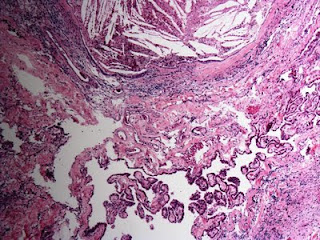Here's a recent case of mine involving a lesion in the third ventricle of a 58-year-old woman who presented with headache and unsteadiness of gait. First, the imaging:
 | |
| Axial CT |
|
 |
| Sagittal T1 MRI |
 |
| Axial T2 MRI |
 |
| Coronal Gradient Echo |
The neuroradiologist thought perhaps the lesion was a craniopharyngioma. But, the neurosurgeon was surprised that the lesion seemed to "pop out". Here's the specimen I received:
 |
| Outer Surface |
 |
| Cut Surface |
I smeared some of the viscous fluid from the cut surface onto a glass slide, cover-slipped it, and viewed it under polarized light:
Those cholesterol crystals certainly seem to suggest the possibility of craniopharyngioma. But, craniopharyngiomas do not have a smooth outer surface and do not just "pop out" into the neurosurgeon's hand. Here was my first glimpse of the histology the next day:
Cholesterol clefts and giant cells. Note in the upper picture that this xanthogranulomatous reaction appears to be continuous with the choroid plexus. Could this be a xanthogranuloma of the choroid plexus? I considered that, until I looked elsewhere on the slide and saw this:
This is the ciliated epithelium characteristic of a colloid cyst of the third ventricle, a tumor that can indeed "pop out" into the neurosurgeon's hand. Gross inspection did not reveal a cyst
per se because the exuberant xanthogranulomatous reaction obliterated it. Cases like this have been described in the literature. For example, Dr. David Louis and colleagues wrote in a 1994 article entitled
Third ventricle xanthogranulomas clinically and radiologically mimicking colloid cysts: Report of two cases (Journal of Neurosurgery. 81(4):605-9, 1994 Oct.) that "histopathologic examination revealed xanthogranulomas of the choroid plexus with only microscopic foci of colloid cyst-like structures." I would argue quite the opposite: that the xanthogranuloma derived from the colloid cyst and extended into the choroid plexus. Indeed, Dr. Peter Burger and colleagues write in the fourth edition of
Surgical Pathology of the Nervous System and Its Coverings that "a xanthogranulomatous reaction occasionally supervenes in colloid cysts, largely replacing the epithelium in some cases."
Cool case.













6 comments:
Nice case. The epithelium by itself could also be from a Rathke's Cleft cyst, so if one were seriously considering craniopharyngioma there is another diagnostic possibility...and as I and others have described one can have mixed craniopharyngioma and Rathke's Cleft Cyst in the same specimen. However the MRI appearances in your case pretty much preclude diagnoses of craniopharyngioma and Rathke's Cleft Cyst since the tumor has no portion in the sella or suprasellar cisterns. A diagnosis of colloid cyst is not strongly suggested by the MRI since the mass is not in the foramen of Monro, and is isolated to the lateral ventricle adherent to the choroid plexus. However, as the epithelium of the lesion is clearly not what one would expect in any choroid plexus tumor (although I have not seen more than one putative "choroid plexus adenoma", so I'm not sure about that one entity's spectrum) there seems little choice but to reach the conclusion you have come to.
Douglas C Miller MD,PhD, still having problems convincing google my password ought to work, so posting as "anonymous".
Great case!! Thanks for sharing!
As always, thank you Dr. Miller for your thoughtful comment.
Thanks for posting this case. The examination of the fluid contents was brilliant!
Thanks, Dr. Poole! I appreciate your kind words....
Thanks for the nice blog. It was very useful for me. Keep sharing such ideas in the future as well. This was actually what I was looking for, and I am glad to came here! Thanks for sharing the such information with us.
James Makker
Post a Comment